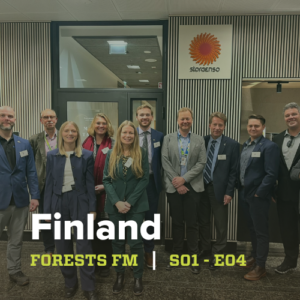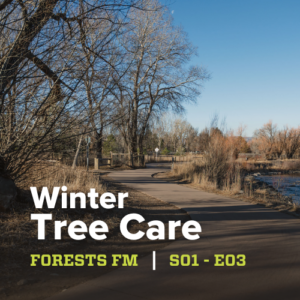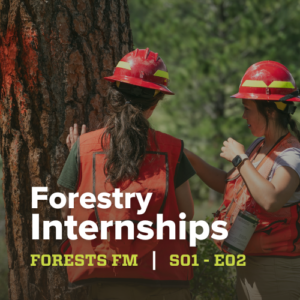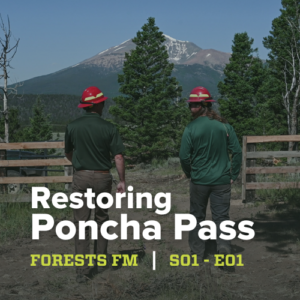Forests FM
The Official Podcast of the Colorado State Forest Service
Welcome to Forests FM, a podcast bringing Colorado’s forests home. From the expansive landscapes of western Colorado, to the urban Front Range and the eastern plains, we share the voices, stories and sounds from forests around Colorado. Each episode shares a glimpse into what it means to preserve and support the health of forests for present and future generations.
Season 01
S01 E04: Finland
“Everything that’s made from fossil-based materials today can be made from a tree tomorrow,” says Amanda West Fordham, Associate Director of Science and Data at the CSFS. She’s describing a key goal of Stora Enso, one of many industry leaders she connected with on a 2023 delegation to Finland.
Caught somewhere between microwave boxes, robots roaming the forests and artificial intelligence, this episode features Amanda’s experiences representing Colorado overseas in a new climate partnership.
Memorandum of Understanding (MOU) – Agreement centered around a shared partnership or priority
US Climate Alliance – Bipartisan collation of governors, state agencies and non-profits committed to upholding the goals of the UN Framework Convention on Climate Change
Senate Bill 23-016 – Greenhouse Gas Emission Reduction Measures
House Bill 19-1261 – Climate Action Plan to Reduce Pollution
Colorado Natural and Working Lands Climate Taskforce – Colorado’s first coordinated effort to address greenhouse gas emissions from natural and working lands
Colorado Forest Action Plan – Road map to improving forest health across Colorado, developed in 2020
Bioeconomy – Industry centered around natural products, resources and services
Circular Economy – Eliminate waste in production through maintenance, reuse, refurbishment, remanufacturing, recycling, composing. Materials remain in circulation as long as possible to reduce waste
Mass Timber – Engineered structural wood products including lumber, veneers, strands, fibers joined with adhesives or fasteners. Allows for smaller diameter trees or a variety of species
Cross-laminated Timber – Combines sawn timber into structural panels that can replace steel or concrete. Can have lower carbon footprint
Biogenic Carbon Storage – Carbon that is stored in biological materials, like plants
Stora Enso – Leading provider of renewable products in packaging, biomaterials and wooden construction
Woody biomass utilization – Raw material from trees that can be used for wood products or energy
Lignode® – A product developed by Stora Enoso, described as “a material that replaces synthetic graphite with lignin, a by-product in the production of cellulose fibre and one of the largest renewable sources of carbon anywhere. Lignin-based carbon can be used in batteries”
Carbon Storage – Trees sequester carbon (absorb from atmosphere), which reduces the amount of greenhouse gases entering the atmosphere in the long term
Ponsse – One of the world’s largest manufacturers of cut-to-length forest machines
Miller Timber Services – Provides comprehensive forest management solutions
Forest Inventory and Analysis Program
Finnish Forestry Centre – Finnish state-funded organization that oversees forest management and landowner engagement
Colorado Forest Products and Wood Utilization
Finnish Research Collaborators
S01 E03: Winter Tree Care
The trees in our backyards and communities might go unnoticed during the cold and quiet winter months, but it’s a great time to think about how to care for them. In this episode, CSFS Urban and Community Forestry Program Manager Carrie Tomlinson explains the importance of urban trees, shares tips for watering, pruning and consulting with an arborist, and offers advice on providing care for your trees into the future.
Tree Care
- CSFS: Urban & Community Forestry
- Article: Late Winter Best Time to Prune Trees
- Dealing with Storm-Damaged Trees
- ISA: Find an Arborist
- The 3 Cut Method
City Forestry Departments
S01 E02: Forestry Internships
Hands-on experience is a critical part of developing a career in natural resources. The CSFS partners with the Warner College of Natural Resources Dean’s Office at Colorado State University to provide paid summer internship opportunities to WCNR undergraduate students each year. In this episode, learn about these positions that allow students to get in the field alongside experienced forestry staff across Colorado.
S01 E01: Restoring Poncha Pass
When insect outbreaks devastated a forest outside of Salida, Colo., CSFS foresters and local partners mounted a collective effort to improve forest health and reduce wildfire risk for residents of Poncha Pass.
Featuring Poncha Pass
Insects and Disease
Wildfire Mitigation
- CSFS: Wildfire Mitigation
- CSFS: Community Wildfire Protection Plans
- CSFS: Protect Your Home and Property from Wildfire
Partners & Programs





